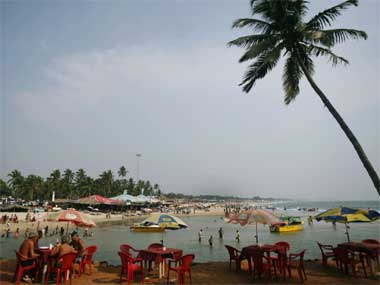New Delhi: Tar ball deposition on Goa’s beaches, a regular phenomenon from June to October every year, is affecting the marine life in the coastal waters of the state, says a new study. Scientists at the National Institute of Oceanography (NIO) in Goa initially thought that the tar ball deposition was due to off-shore oil exploration, oil tanker accidents, oil-well blow-outs, accidents or deliberate release of bilge and ballast water from ships. [caption id=“attachment_119671” align=“alignleft” width=“380”]  A file photograph of Goa[/caption] However, when there were deposits on the Goan beaches even though no cases of oil spills or accidents were reported in 2010 and 2011, the NIO decided to conduct further study on this. To carry out the study the NIO also collected samples from Baga, Candolim, Calungute and Mandrem beaches from North Goa and Velsao, Betalbatim, Colva and Benaulim from South Goa. “There were no reports of oil spills in the Arabian Sea or on the Western coastal belt. We assume that some unknown spills or tanker routes might be the cause for the formation of present tar balls,” the study said. The study states that after the oil spill, weathering process also causes half of the oil to disperse within 24 hours. After 24 hours, depending on the sea state, a water-in-oil emulsion is formed and this increases with the salinity of water. The winds, waves and turbulence on the sea surface cause the emulsion to break into smaller pieces, which eventually become tar balls. The Goan coast is close to one of the Sea Lines of Communication (SLOC), which is used by ships and international oil tankers coming from and going towards the Persian Gulf. Thus all the oil spilled in the Arabian Sea eventually gets deposited on the Western coast in the form of tar balls in the monsoon season, while the circulation pattern and surface winds favour the transportation of these tar balls, it said. “During the monsoon and prior to its arrival, the sea is very rough and winds blow towards the coast. This brings the tar balls on the coast during June to October. This is a reason why we see tar balls getting washed away on the Goan beaches,” said A K Saran, a scientist with the NIO. “The Western coast is more conducive to tar ball deposition than the east coast and this might be due to the international tanker traffic in the Arabian Sea,” the study said. Such depositions are also found in Surat and Porbunder in Gujarat and Karnataka coastline. However, the deposition is high on the Goan beaches. Floating tar residues are observed in minimal quantities in Atlantic, Pacific and Indian oceans, but are found in significant quantities in the closed seas such as Red Sea, the Mediterranean. However, in recent years, a significant rise in tar quantities has been observed in North Indian Ocean, the study states. PTI
To carry out the study the NIO collected samples from Baga, Candolim, Calungute and Mandrem beaches from North Goa and Velsao, Betalbatim, Colva and Benaulim from South Goa.
Advertisement
End of Article
Written by FP Archives
see more


)

)
)
)
)
)
)
)
)



